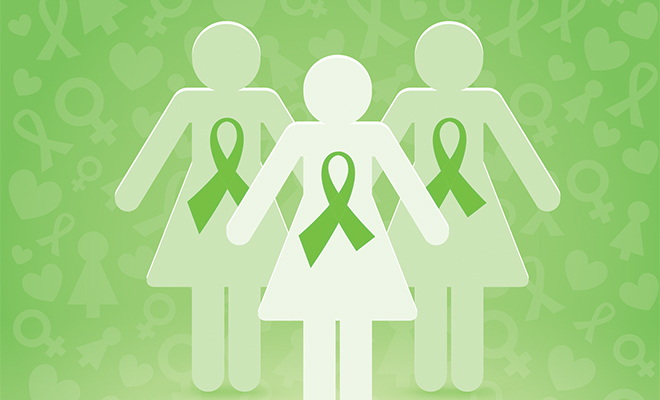
Vaginal melanoma: the underside of melanoma
Angie Fagan Meshad had just returned to her home town from visiting her sister, Brenda, in California over Memorial Day weekend in 2015. Angie, who was 58 at the time, had been experiencing some abnormal spotting and bleeding, so she made an appointment with her gynecologist.
After an initial exam, Angie’s doctor thought she might have a bladder infection, but he also referred her to an oncologic gynecologist for an appointment the following day. Initially, the oncologist thought she had cervical cancer, but after more tests and screenings, Angie was diagnosed with vaginal melanoma. None of her physicians had ever seen vaginal melanoma, much less treated it.
Immediately, Angie’s family and friends began to scour the Internet looking for a medical team experienced in treating this aggressive cancer. Angie decided to head to a major medical center that has one of the most active melanoma treatment programs in the nation. This medical center also provides treatment for rare forms of cancer such as vaginal melanoma.
Doctors confirmed Angie’s greatest fear. She had stage 4 vaginal melanoma, with her tumor measuring approximately 5 centimeters. The treatment regimen of chemotherapy combined with an immunotherapy called Keytruda® worked the first few months as the tumor shrank in size. However, in December of that same year, her checkup visit to the medical center revealed that the treatment had stopped working and the tumor was growing again. She wasn’t a candidate for surgery due to the nature of the cancer. Angie was left with the harshness of more chemotherapy and expensive drugs. She lost her battle with vaginal melanoma on March 16, 2016.
To get an understanding of vaginal melanoma, we first need to understand cancer. Cancer starts when cells in the body begin to grow out of control and spread to other areas of the body. Melanomas develop from pigment-producing cells that give skin its color. They are typically found on sun-exposed areas of the skin but can form in the vagina or other internal organs. About 9 of every 100 cases of vaginal cancer are melanomas. Melanomas tend to grow in the lower or outer portion of the vagina. The tumors vary in size, color and growth pattern.
Certain risk factors increase a woman’s chances of getting vaginal melanoma:
• Diethylstilbestrol (DES): Women whose mothers took this drug during their pregnancy between the late 1940s and 1971 have an increased risk.
• Infection with human papilloma virus, or HPV
• Cervical cancer or pre-cancer
• Smoking
• Excessive use of alcohol
• Infection with human immunodeficiency virus, or HIV
About 2 of every 100 melanomas are diagnosed in the vagina or vulva. White women are at higher risk than African-American women, and women over 50 also have a greater likelihood of getting the cancer.
Currently, there is no precise screening for vaginal melanoma because it is a very rare condition, but often a doctor may find it during a routine cervical screening or Pap test when the vagina and vulva are also examined. Some doctors recommend that women use a mirror and look at the entrance to their own vagina regularly to check for any changes to the skin. Red, irritated, white or darkly colored areas may be a sign of vaginal melanoma. In addition, growths, nodules, bumps or sores require a visit to the gynecologist. Visual checks may help women to pick up cancer at an early stage. Some other warning signs can include itching, bleeding and pain.
Treatment for vaginal melanoma depends on the stage of the cancer. Surgery is often recommended as well as chemotherapy, radiation and drugs. Immunotherapies such as Keytruda, using a patient’s immune system to fight cancer, are becoming more successful as well. In Angie’s case, the next option that the medical center’s oncologists recommended was viral therapy, using viruses to kill the cancer. Unfortunately, Angie’s body was too weak to try this new treatment.
Angie’s sister, Brenda Fagan Johnson, is still supporting her sister’s cause and urging other women to increase their awareness of vaginal melanoma. “Science is catching up with some of the more aggressive cancers. Keep researching, don’t give up and be willing to travel to another city where experts have had positive outcomes,” Brenda urges. “There are many organizations that can help fund women who do not have insurance or the means to pay for treatment.”
Angie’s wish was that all women be aware of vaginal melanoma, its signs and symptoms and where to go for help, and also that women maintain a regular checkup schedule. Her family and friends are planning a walk in October to raise money and awareness to support women who may not be able to pay for their tests and treatment.
Vaginal melanoma may be uncommon, but its toll can be deadly. Scientists and medical professionals are still trying to understand it and treat it with the most success. Knowing your risks and talking to your doctor will help you make more informed lifestyle and healthcare choices. HLM
Sources: cancer.net, mdanderson.org and cancer.org.







